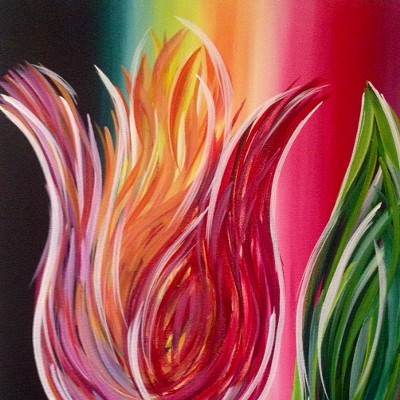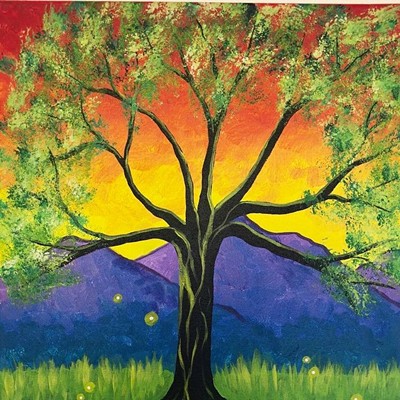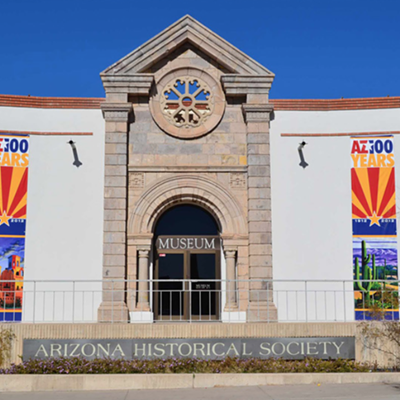Painter Gail Marcus-Orlen, for instance, obediently started out her oil on canvas "Checkmate #1" with three painted black-and-white cats occupying a tidy black-and-white checkerboard. But Marcus-Orlen, well known for beautifully colored paintings that hover ambiguously between still life and domestic surrealism, couldn't resist adding color. Delicately colored hummingbirds and flowers, in lavender, yellow and pink, make an incursion at the top of her picture. And even in the optical-illusion background, her well-behaved black-and-white checks fade to a whiter shade of pale.
Marcus-Orlen may be the most flagrant violator of the rules, but she's hardly alone. A warm yellow light creeps into Betina Fink's "Cross," a tiny painting of a gray arched window, and a red flame lights up Lucinda Young's "Untitled, Tucson, Easter," a mixed media of a female torso strung up on a black cross. Jerre Johnston's "The Delay of Light" likewise has injected eerie gold into an atmospheric mixed-media piece that evokes a desolate architectural interior.
Gwyneth Scally, a young painter of astonishing realist gifts, abandoned black and white altogether, substituting coffee and cream. Her "Duck and Drake," an oil on board, porcelain and resin, is a powerful portrait of an older man, set against a plain modernist backdrop. An inset shelf holding the ducks of the title makes a jarring juxtaposition to his sorrows. Rendered in white ceramic, these vicious little beasts lash out with unreal toothy beaks.
Daniel Martin Diaz made his pencil drawing "Mysticus Dolor" in sepia tones; exploring Catholic imagery, as is his wont, he traces out a Queen of Heaven whose earthly flesh has rotted away.
Who cares if these pictures are not all black and white? With works this interesting, it hardly matters that their makers have chafed against the exhibition strictures. But some of the participants seem to have enjoyed the push to do something outside their usual line. Cynthia Miller, another artist celebrated for her lively colors, made an energetic portrait, "Rolf," an acrylic on canvas that positively delights in its delicious range of whites and grays. Watercolorist Barbara Smith, who typically records the tinted hills of Patagonia, surprises with an abstract monoprint, "Cadence," a swathe of painterly gray and white. Even Nancy Tokar Miller, master of abstracted colored landscapes, tried her hand at black ink on paper, turning out an Asian-inspired calligraphy.
A few artists really took black and white to heart. Simon Donovan, whose downtown snake bridge has just racked up yet another award, made the brilliant contrast of pure black and white an important element in his untitled wall sculpture. His intricate carving is a trompe l'oeil in 3-D, its geometric patterns shaped by receding bands of black and protruding counterparts in white. Bailey Doogan took charcoal where it's never gone before in "Marilyn's Renaissance," a wonderful drawing on primed paper. This nuanced portrait of a woman pushes charcoal first into undisciplined painterly directions, spilling into broad patches of dark and light, and then tames it into a tidy drawing material, cross-hatched and well-behaved.
Chris Rush gets the prize for most original medium: He made a chalk drawing of the back of a man's head on a schoolchild's blackboard. Alice Leora Briggs, who like Rush is in the current show over at Etherton, contributed one of her elaborate scratchboard drawings in black and white. This one, "The Dead," is a chilly scene of a morgue. (The other Etherton participant, Jim Waid, is inexplicably AWOL here, though this master colorist has some uncharacteristic black-and-white pieces in the Etherton show.)
Speaking of AWOL and things military, Alfred Quiróz, Tucson's most political artist, reliably checks in with a screeching President Bush in a wooden box painted gray, green, black and white. Beyond Bush, the Twin Towers stand ready and willing to justify his every attack on civil liberties and foreign lands alike. Michael Chittock contributed a fine sketchbook of war images, "CNN Live," gleaned from the recent invasion of Iraq played live on TV. Fluid ink wash drawings depict the helicopters and tanks that tormented a civilian population. An accompanying painting, a hellish evocation of arms and smoke and terror, is in somber browns, tans and grays. Picasso's "Guernica" notwithstanding, the sufferings of war are perhaps too complicated, too wrenching, to be rendered in simple black and white.














